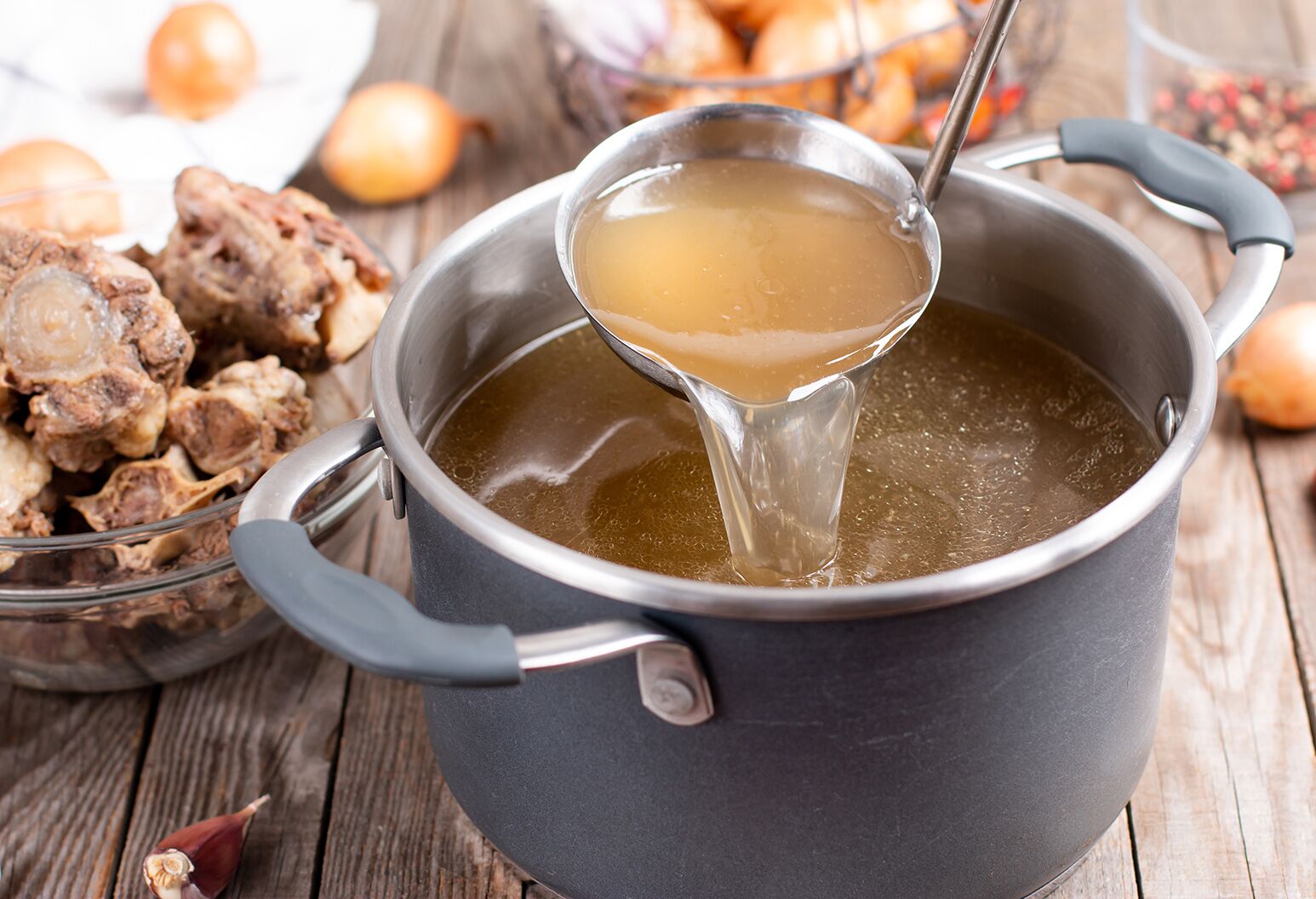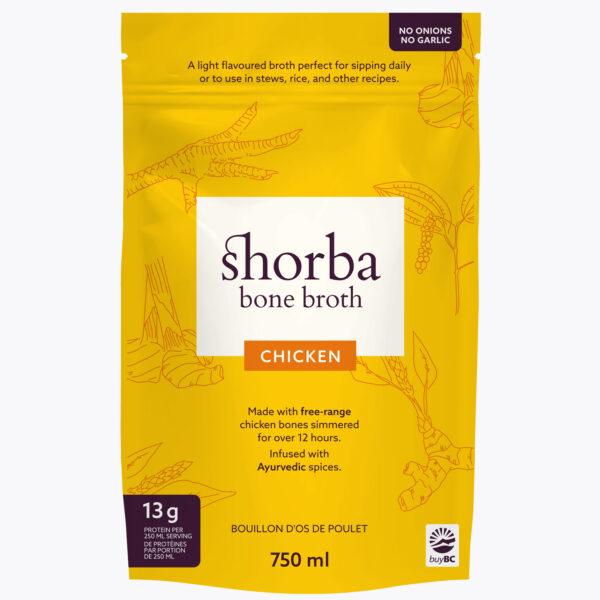Why the Benefits Of Bone Broth Go Beyond Simple Nutrition
Why the Benefits Of Bone Broth Go Beyond Simple Nutrition
Blog Article
The Ultimate Guide to Enjoying and making Organic Bone Broths at Home
Bone broth has actually obtained focus for its numerous wellness advantages and culinary convenience. Crafting organic bone broth in the house permits people to manage the top quality of components, guaranteeing a nourishing end result. Recognizing the option of bones, necessary flavoring components, and proper food preparation strategies is vital. As the procedure unravels, one may question just how to raise their broth beyond the essentials and integrate it into everyday dishes for boosted flavor and nutrition.
Recognizing the Health Perks of Bone Broth
Bone brew has actually been a staple in various foods for centuries, its health and wellness benefits have obtained substantial interest in recent years. Rich in collagen, amino acids, and minerals, bone broth is commonly promoted for its prospective to support joint wellness, boost intestine function, and enhance skin flexibility. The gelatin stemmed from cooked bones might assist digestion and help seal the intestine cellular lining, potentially alleviating concerns like leaky digestive tract syndrome.Furthermore, the presence of nutrients such as glucosamine and chondroitin might contribute to decreased inflammation and discomfort alleviation in joints. In addition, bone brew is hydrating and can serve as a nutritious base for stews and soups. Numerous advocates likewise declare that it boosts the immune system, thanks to its mineral profile. In general, the revival of passion in bone brew is connected to its perceived capability to promote overall wellness and support various physical functions.
Picking the Right Bones for Maximum Flavor and Nutrition
What aspects should one think about when picking bones for broth preparation? The type of bones made use of greatly impacts both taste and dietary value. It is crucial to pick bones that include a mix of marrow bones, joint bones, and meaningful bones. Marrow bones offer healthy fats and abundant tastes, while joint bones contribute collagen, improving the broth's nutritional profile.Additionally, sourcing bones from pasture-raised or grass-fed pets warranties better and even more nutrients, as these pets are usually much healthier. The freshness of the bones is likewise important; picking bones from regional butchers or farmers' markets can assure perfect flavor. Bone size matters as well; larger bones release even more jelly, leading to a richer broth. Finally, taking into consideration the sort of animal-- hen, beef, or fish-- can affect the last taste, enabling for functional brew choices customized to private choices.
Necessary Components for a Delicious Bone Brew

Quality Bone Selection
The structure of a savory bone brew depends on the cautious selection of top notch bones. Sourcing natural, pasture-raised or grass-fed bones is crucial, as these choices are most likely to be complimentary from damaging additives and provide exceptional nutrients. Varieties such as beef, poultry, or lamb bones each present distinct tastes and wellness advantages. Bone types, including marrow bones, knuckle bones, and oxtails, contribute jelly and collagen, enhancing the broth's appearance. Choosing bones with a mix of meat and connective tissue can also add splendor and deepness. In addition, picking bones with visible marrow ensures a nutrient-dense broth, raising the general high quality. Inevitably, investing time in quality bone choice prepares for a beneficial and tasty brew.
Aromatic Taste Enhancers
Picking high-grade bones sets the stage for a healthy and abundant bone broth, however it is the addition of fragrant flavor boosters that really elevates the dish. Active ingredients such as onions, garlic, and carrots not only pass on sweetness yet also add depth to the brew. Fresh natural herbs like thyme, bay, and parsley leaves add an aromatic note, while seasonings such as black peppercorns and cloves present heat and complexity. In addition, incorporating a splash of apple cider vinegar can help remove minerals from the bones, enriching the brew. These taste enhancers produce a harmonious mix, changing a simple broth into a mouthwatering structure for sauces, stews, or soups, making it a flexible component in any kind of cooking collection.
Step-by-Step Guide to Making Bone Broth at Home
Creating bone broth at home can be a satisfying culinary endeavor that boosts both flavor and nourishment in numerous recipes. To begin, one must pick premium bones, preferably from organic or grass-fed sources. Roasting the bones at 400 ° F for concerning 30 minutes can heighten the flavor. Next, move the roasted bones to a huge pot or slow-moving cooker and cover them with cool water. Including a dash of vinegar assists extract minerals from the bones.Include fragrant veggies like onions, carrots, and celery for included depth, in addition to natural herbs and flavors as preferred. Bring the mix to a boil, after that reduce to a simmer. It is necessary to let the brew simmer for a minimum of 12 hours, however longer is better for optimum richness. Lastly, pressure the broth with a fine-mesh sieve and shop it in airtight containers, all set to elevate dishes with its my website nutritious significance.

Tips for Improving Your Bone Brew Simmer
While simmering bone broth, keeping the best temperature level and timing is vital for achieving a tasty and abundant result. A gentle simmer, weblink preferably in between 190 ° F and 210 ° F, aids essence optimum nutrients and tastes without boiling, which can make the brew cloudy. It is recommended to check the pot carefully, changing the warm as required to keep this simmer.Timing is additionally important; a longer simmer, generally ranging from 12 to 48 hours, enables for deeper flavor removal and collagen launch. For chicken bones, a 12 to 24-hour simmer is adequate, while beef bones take advantage of longer food preparation times.Additionally, skimming any foam or impurities that rise to the surface area throughout the very first couple of hours can enhance the broth's clarity and preference. Lastly, ensuring the pot is covered during simmering helps to retain moisture and intensify the flavors, creating an extra enjoyable output.
Creative Ways to Make Use Of Bone Brew in Your Cooking
Incorporating bone broth into various meals raises both taste and nutritional worth. Chefs and home cooks alike locate that using bone broth as a base for soups and stews improves deepness and richness, transforming straightforward recipes right into hearty dishes. It can additionally be used in risottos, where the brew changes water, permitting the grains to absorb its mouthwatering essence.Additionally, bone broth functions as an outstanding food preparation fluid for grains like quinoa or rice, infusing them with nutrients and flavor. For an added spin, it can be made use of in braising meats, resulting in tender, flavorful results. Even sauces gain from a sprinkle of bone broth, enhancing their taste profile.Moreover, bone broth can be incorporated right into healthy smoothies for an unanticipated health increase, supplying protein and nutrients without jeopardizing preference. These creative applications display the convenience of bone brew in day-to-day cooking, making it a very useful kitchen staple.
Storing and Maintaining Your Home Made Bone Brew
Proper storage space and conservation of homemade bone broth is crucial for preserving its taste and dietary advantages. Cold strategies and refrigeration best techniques play an important duty in extending the broth's service life. Understanding these techniques can help ensure that the brew stays tasty and risk-free for future usage.

Icing Up Methods Discussed
Freezing strategies are crucial for successfully storing and protecting self-made bone broth, ensuring its abundant tastes and nutrients stay undamaged for future use. To ice up bone broth, it is suggested to allow it cool completely prior to transferring it to storage space containers. Glass jars, silicone mold and mildews, or durable freezer bags are ideal alternatives. When using containers, leave room on top for expansion during cold. Portioning the broth right into smaller amounts allows for simple thawing and reduces waste. Tag containers with the day and contents for easy identification. For peak high quality, eat the frozen brew within 3 to six months - Beef Broth. Thawing can be performed in the fridge or by utilizing a microwave, ensuring that the broth is heated completely before usage
Refrigeration Best Practices
While numerous emphasis on freezing as a technique of preservation, refrigeration additionally plays a crucial role in saving homemade bone brew efficiently. As soon as cooled, bone broth must be moved to airtight containers, assuring marginal air direct exposure to prevent perishing. It is advisable to cool brew within 2 hours of food preparation to preserve its high quality. Normally, homemade bone brew can be saved in the fridge for as much as five days. Classifying containers with days can aid track freshness. For peak flavor and safety, broth should be reheated to a moving boil prior to consumption. If longer storage is required, freezing stays Recommended Site an exceptional choice, however proper refrigeration practices guarantee that bone brew continues to be delicious and nourishing for short-term usage.
Regularly Asked Inquiries
Can I Make Use Of Frozen Bones for Making Bone Brew?
The concern of using icy bones for bone broth arises frequently (Bone Broth Delivery). Professionals concur that frozen bones can be used properly, but they need to be defrosted prior to food preparation to ensure ideal flavor and nutrient extraction
For How Long Can I Shop Homemade Bone Broth?

Is It Safe to Reheat Bone Broth Several Times?
Reheating bone brew numerous times can present safety problems - Bone Broth Delivery. Each reheating cycle increases the threat of bacterial development. It is a good idea to reheat just as soon as and save any type of leftovers without delay to ensure safety and top quality
Can I Add Veggies to the Broth for Taste?
Including vegetables to broth boosts taste and dietary value. Usual options include carrots, onions, and celery. The veggies instill their essence right into the broth, developing a richer and much more savory end product.
What's the Finest Means to Thaw Frozen Bone Brew?
To defrost frozen bone broth, one can place it in the fridge overnight, utilize a microwave on low warm, or immerse the sealed container in cozy water, making sure also defrosting without compromising flavor or nutrients. It is essential to pick bones that include a mix of marrow bones, joint bones, and weighty bones. Marrow bones offer abundant flavors and healthy and balanced fats, while joint bones add collagen, enhancing the brew's nutritional profile.Additionally, sourcing bones from pasture-raised or grass-fed pets guarantees greater top quality and more nutrients, as these animals are usually much healthier. Bone kinds, including marrow bones, knuckle bones, and oxtails, add gelatin and collagen, boosting the brew's texture. Picking premium bones sets the phase for a nutritious and rich bone brew, but it is the enhancement of aromatic flavor enhancers that genuinely boosts the recipe. Even sauces profit from a sprinkle of bone brew, enhancing their preference profile.Moreover, bone broth can be integrated right into smoothies for an unforeseen wellness increase, giving healthy protein and nutrients without jeopardizing preference.
Report this page